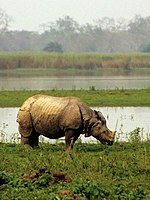Portal:India/SC Summary/SA Kaziranga National Park
| This page is currently inactive and is retained for historical reference. Either the page is no longer relevant or consensus on its purpose has become unclear. To revive discussion, seek broader input via a forum such as the village pump. |
Kaziranga National Park (Assamese: কাজিৰঙা ৰাষ্ট্ৰীয় উদ্যান, IAST: kājirangā rāstriya uddyāna), is a national park in the Golaghat and Nagaon districts of Assam, India. It is a World Heritage Site, and two-thirds of the world's Great One-horned Rhinoceroses live in the park. Kaziranga has the highest density of tigers among protected areas in the world and was declared a Tiger Reserve in 2006. The park has large breeding populations of elephants, water buffalo and swamp deer. Kaziranga is recognised as an Important Bird Area by Birdlife International for conservation of avifaunal species. The park has achieved notable success in wildlife conservation compared to other protected areas in India. Located on the edge of the Eastern Himalaya biodiversity hotspot, the park combines high-species diversity and visibility.
Kaziranga is a vast expanse of tall elephant grass, marshland and dense tropical moist broadleaf forests crisscrossed by four major rivers, including the Brahmaputra, and has numerous small bodies of water. Kaziranga has been the theme of several books, documentaries and songs. The park celebrated its centenary in 2005 after its establishment in 1905 as a reserve forest. (more...)

